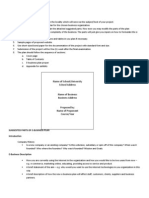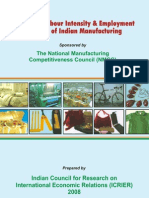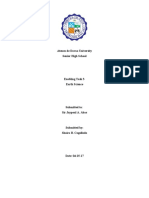World,: Recent Assessment
World,: Recent Assessment
Uploaded by
salamasta12Copyright:
Available Formats
World,: Recent Assessment
World,: Recent Assessment
Uploaded by
salamasta12Original Title
Copyright
Available Formats
Share this document
Did you find this document useful?
Is this content inappropriate?
Copyright:
Available Formats
World,: Recent Assessment
World,: Recent Assessment
Uploaded by
salamasta12Copyright:
Available Formats
32
Topics include recent scientific findings obtained in various natural hazard areas and assessment of actual and
potential damage from earthquakes, floods and landslides. Of particular importance are measures that can be
taken to mitigate these hazards ranging from use of new algorithms for structural engineering to warning
systems for a given region. At a time when natural disasters are widespread, engineers play a key role.
Construction methods and building codes are changing; current knowledge shapes the direction of these changes.
The research results presented in these proceedings will benefit both the academic and practicing communities
around the world, strengthening the relationship between these two important parties.
The War of Desire and Technology at the Close of the Mechanical Age, Allucquère Rosanne Stone.
1995. The MIT Press, Cambridge, MA. 212 pages. ISBN: 0-262-19362-0. $22.50.
It’s a popular observation these days that computer-mediated communication (e-mail correspondence, Internet
discussion groups and chat spaces, etc.) differs from more traditional modes involving telephones, the postal
service, or just ourselves face-to-face. When we send messages across the cybersphere or post to electronic
discussions, we are not required to reveal much about ourselves unless we choose to - and even then, only if we
choose to tell the truth. Facts about our age, name, gender race, and physical characteristics can easily be
withheld or altered, giving us the means to try on alternative personae - in a sense, to recreate ourselves. this,
Stone shows is both tremendously exciting and potentially very dangerous.
In a series of intellectual provocations, Stone moves from busy cyberlabs to the electronic solitude of the
Internet, from phone sex to &dquo;virtual cross-dressers,&dquo; and from the Vampire Lestat to the trial of a man accused of
having raped a woman by seducing on e of her multiple personalities. Unlike some advocates (and some critics)
of the virtual life, Stone never forgets that we live principally in our bodies; and the erotic dimension of life,
both virtual and traditional, remains central to her analysis.
INFORMATION RESOURCES
The Elements of Information Gathering, Donald E. Zimmerman and Michel Lynn Muraski. 1995. Ornyx
Publishing, Phoenix, AZ. 256 pages. ISBN: 0-89774-800-X. $19.95.
Created as a working reference for scientific and technical professionals, as well as a textbook for technical
communication courses, the book is organized into three main sections that lead the reader from the basic
principles of information gathering to the more sophisticated methods of locating and organizing scientific data.
The first part describes strategies for starting an information search, and then explains the process for retrieving,
evaluating, and managing literature, or how to organize information gathered in the first steps of the search.
The second and third parts describe more advanced methods of gathering and analyzing primary information from
interviews, surveys, usability tests, ethnography, case studies, and statistics.
The book also explains how to identify and use electronic sources, retrieve government publications, use
interlibrary loan services, and create a bibliographic database.
Super Solvers Gizmos & Gadgets!, 1995. For ages 7 to 12. The Learning Company, Fremont, CA.
$45.00.
Super Solvers Gizmos & Gadgets! has over 260 puzzles and simulations that help children understand the basic
principles of physical science such as force, magnetism, electricity, gears, balance, energy sources and simple
machines. The player is challenged to outrace Morty Maxwell, the Master of Mischief, and restore the future of
scientific research. The only way to beat Morty to the finish and save the Shady Glen Technology Center is to
solve science puzzles, collect parts and build a faster racing gizmo.
On-screen simulations build awareness of the physical science principles demonstrated by everyday objects such
as wheelbarrows, light bulbs and scales. Eight different puzzle types automatically adjust to a player’s skill
level. Children are given immediate feedback on their answers and clues to help them find the correct solutions.
There is no time limit to solving puzzles so children can experiment with each of the puzzles and simulations as
long as they would like. Researched and tested extensively with educators, parents and children, Gizmos
Downloaded from bst.sagepub.com at UCSF LIBRARY & CKM on March 8, 2015
You might also like
- Fundamentals of Communication SystemsDocument18 pagesFundamentals of Communication SystemsNoegroho Wetjaksono0% (1)
- Improving Urban Schools - Equity and Access in K-12 STEM Education For AllDocument208 pagesImproving Urban Schools - Equity and Access in K-12 STEM Education For AllFabLab EIUNo ratings yet
- Action Plan For Adopt A School ProgramDocument2 pagesAction Plan For Adopt A School ProgramMary Flor88% (26)
- People vs. Pimentel - DIGESTDocument1 pagePeople vs. Pimentel - DIGESTTiff100% (1)
- Meaning and Types of RightsDocument4 pagesMeaning and Types of Rightssimply_coool67% (3)
- Introduction To Science Technology and SocietyDocument23 pagesIntroduction To Science Technology and SocietyFatima AbayonNo ratings yet
- STS Module 1 Lesson 1Document4 pagesSTS Module 1 Lesson 1Gede RuizNo ratings yet
- Science Comes From The Latin Word Scientia, Meaning Knowledge'. It Refers To A Systematic andDocument3 pagesScience Comes From The Latin Word Scientia, Meaning Knowledge'. It Refers To A Systematic andSunny LavenderNo ratings yet
- Shu-Heng Chen - Big Data in Computational Social Science and Humanities (2018, Springer) PDFDocument391 pagesShu-Heng Chen - Big Data in Computational Social Science and Humanities (2018, Springer) PDFGustavo MargaritesNo ratings yet
- Science 1 - John Allenson Dacosin - Bsa 2aDocument6 pagesScience 1 - John Allenson Dacosin - Bsa 2aJohnallenson DacosinNo ratings yet
- Introduction To Science Technology and SocietyDocument16 pagesIntroduction To Science Technology and SocietymelabbyhahaNo ratings yet
- A Rule Set For The Future: Tara McphersonDocument23 pagesA Rule Set For The Future: Tara McphersonŞule Topçuoğlu Güler100% (1)
- Module 1 Section 1 Lecture Slides STUDENTSDocument12 pagesModule 1 Section 1 Lecture Slides STUDENTSJewela NogasNo ratings yet
- STSModuleBMA PDFDocument90 pagesSTSModuleBMA PDFmarwin violagoNo ratings yet
- Module 1 STSDocument6 pagesModule 1 STSShaina GarciaNo ratings yet
- Intended Learning Outcomes: STS 101 Introduction To Science Technology and SocietyDocument4 pagesIntended Learning Outcomes: STS 101 Introduction To Science Technology and SocietyChrissa Barcebal CamposNo ratings yet
- Jmcknight IMED380 03 Fall16Document10 pagesJmcknight IMED380 03 Fall16John Carter McKnightNo ratings yet
- Sts Module 1 6 Lecture Notes 3 7Document79 pagesSts Module 1 6 Lecture Notes 3 7Mckleen Jeff Onil ArocoNo ratings yet
- Tommaso Venturini, Pablo Jensen and Bruno Latour (2015) Fill in The Gap. A New Alliance For Social and Natural SciencesDocument4 pagesTommaso Venturini, Pablo Jensen and Bruno Latour (2015) Fill in The Gap. A New Alliance For Social and Natural SciencesNico SanhuezaNo ratings yet
- Gays in The Military EssayDocument10 pagesGays in The Military Essayaxmljinbf100% (2)
- Lesson 1: ScienceDocument4 pagesLesson 1: Sciencerenz daveNo ratings yet
- Some Thoughts On EducationDocument237 pagesSome Thoughts On Educationmmbrenn2No ratings yet
- Wired Shut: Copyright and the Shape of Digital CultureFrom EverandWired Shut: Copyright and the Shape of Digital CultureRating: 3.5 out of 5 stars3.5/5 (7)
- GST AnswerDocument5 pagesGST AnswerJAYNo ratings yet
- Additional Reading Material Fo Introduction of STS PDFDocument4 pagesAdditional Reading Material Fo Introduction of STS PDFNigos Khim CyrilNo ratings yet
- 5 Page Essay ExampleDocument11 pages5 Page Essay ExampleToniNo ratings yet
- WATTS 2007 A 21st Century Science NatureDocument1 pageWATTS 2007 A 21st Century Science NatureaxiomatizadorNo ratings yet
- Knowledge Machines: Digital Transformations of the Sciences and HumanitiesFrom EverandKnowledge Machines: Digital Transformations of the Sciences and HumanitiesNo ratings yet
- Easy Ways To Write An EssayDocument11 pagesEasy Ways To Write An Essayasdf12345No ratings yet
- Physics Senior Thesis IdeasDocument8 pagesPhysics Senior Thesis Ideastiffanyyounglittlerock100% (1)
- Section 1Document35 pagesSection 1Angela MacapagalNo ratings yet
- Handouts For StudentsDocument21 pagesHandouts For StudentsPoblacion 04 San LuisNo ratings yet
- Full Mathematics Education in The Information Age Stacy A. Costa PDF All ChaptersDocument62 pagesFull Mathematics Education in The Information Age Stacy A. Costa PDF All Chaptersmeaneyukab100% (2)
- Handouts For StudentsDocument20 pagesHandouts For StudentsHazel GonzalesNo ratings yet
- Data ScienceDocument310 pagesData ScienceHector JuradoNo ratings yet
- Module 1. Unit 1.: Introduction To Science, Technology, and SocietyDocument12 pagesModule 1. Unit 1.: Introduction To Science, Technology, and SocietyNenia millaminaNo ratings yet
- PDF Genetic Dissection of Complex Traits 1st Edition D. C. Rao DownloadDocument84 pagesPDF Genetic Dissection of Complex Traits 1st Edition D. C. Rao Downloadledentdhini100% (3)
- Every Science That Has Thriven Has Thriven Upon Its Own SymbolsDocument23 pagesEvery Science That Has Thriven Has Thriven Upon Its Own SymbolskayakbluemailNo ratings yet
- Iron Cage ThesisDocument8 pagesIron Cage Thesisbrittanyjonescolumbia100% (2)
- Osiris, Volume 38: Beyond Craft and Code: Human and Algorithmic Cultures, Past and PresentFrom EverandOsiris, Volume 38: Beyond Craft and Code: Human and Algorithmic Cultures, Past and PresentNo ratings yet
- Some Thoughts On Education and Political Priorities PDFDocument237 pagesSome Thoughts On Education and Political Priorities PDFMiguel ArmenterosNo ratings yet
- The Magic Box and Collage Responding ToDocument27 pagesThe Magic Box and Collage Responding TotyanafmNo ratings yet
- The Spy in the Coffee Machine: The End of Privacy as We Know ItFrom EverandThe Spy in the Coffee Machine: The End of Privacy as We Know ItNo ratings yet
- Researching a Posthuman World: Interviews with Digital ObjectsFrom EverandResearching a Posthuman World: Interviews with Digital ObjectsNo ratings yet
- STS Finals Module - PATALINGHUGDocument32 pagesSTS Finals Module - PATALINGHUGShamae PatalinghugNo ratings yet
- Instant download The Future of the Curriculum School Knowledge in the Digital Age Ben Williamson pdf all chapterDocument60 pagesInstant download The Future of the Curriculum School Knowledge in the Digital Age Ben Williamson pdf all chapteraledoerroa3v100% (3)
- A New Kind of Social Science: The Path Beyond Current (IR) Methodologies May Lie Beneath ThemDocument65 pagesA New Kind of Social Science: The Path Beyond Current (IR) Methodologies May Lie Beneath Themgiani_2008No ratings yet
- Humans Need Not Apply: A Guide to Wealth & Work in the Age of Artificial IntelligenceFrom EverandHumans Need Not Apply: A Guide to Wealth & Work in the Age of Artificial IntelligenceRating: 3.5 out of 5 stars3.5/5 (19)
- New PPT On STS 2024Document17 pagesNew PPT On STS 2024John Caleb G. FACURIBNo ratings yet
- Ignorance Is Bliss Thesis StatementDocument4 pagesIgnorance Is Bliss Thesis Statementjuliepatenorman100% (2)
- Survival of the Richest: escape fantasies of the tech billionairesFrom EverandSurvival of the Richest: escape fantasies of the tech billionairesNo ratings yet
- Ethics in Engineering, 2005, 339 Pages, Mike Martin, Roland Schinzinger, 0072831154, 9780072831153, Mcgraw-Hill Education, 2005Document17 pagesEthics in Engineering, 2005, 339 Pages, Mike Martin, Roland Schinzinger, 0072831154, 9780072831153, Mcgraw-Hill Education, 2005Zakir HossenNo ratings yet
- Dignity and Utility of Privacy and Information Sharing in The Digital Big Data AgeDocument42 pagesDignity and Utility of Privacy and Information Sharing in The Digital Big Data Age曾養騰No ratings yet
- Galloway, The Gender of Math (2022)Document24 pagesGalloway, The Gender of Math (2022)Viandante852No ratings yet
- Full download Information Foraging Theory Adaptive Interaction with Information 1st Edition Peter L. T. Pirolli pdf docxDocument82 pagesFull download Information Foraging Theory Adaptive Interaction with Information 1st Edition Peter L. T. Pirolli pdf docxanjietlaqnaNo ratings yet
- Instant download The Cybernetics Moment Or Why We Call Our Age the Information Age 1st Edition Ronald R. Kline pdf all chapterDocument67 pagesInstant download The Cybernetics Moment Or Why We Call Our Age the Information Age 1st Edition Ronald R. Kline pdf all chapterraenakearyh4100% (2)
- The Virtual CampfireDocument200 pagesThe Virtual CampfireIbrahim KhaladNo ratings yet
- Edtech-MacgilchristPotterWilliamson_Challenginginequitableimpacts_Editorial_2024Document6 pagesEdtech-MacgilchristPotterWilliamson_Challenginginequitableimpacts_Editorial_2024bordisNo ratings yet
- Essay of Air PollutionDocument8 pagesEssay of Air Pollutionafibykkhxxhdid100% (2)
- Can Math Help Explain Our Bodies - Michigan TodayDocument6 pagesCan Math Help Explain Our Bodies - Michigan TodayPurvesh KumarNo ratings yet
- Possible Ece Thesis TopicsDocument7 pagesPossible Ece Thesis Topicscatherineaguirresaltlakecity100% (2)
- Erratum To: Column Liquid Chromatographic Analysis of Quinine in Human Plasma, Saliva and Urine'' (J. Chromatogr. B, 616 (1993) 151-154)Document1 pageErratum To: Column Liquid Chromatographic Analysis of Quinine in Human Plasma, Saliva and Urine'' (J. Chromatogr. B, 616 (1993) 151-154)salamasta12No ratings yet
- Introducing The New Diagnostic Exercise'' ColumnDocument1 pageIntroducing The New Diagnostic Exercise'' Columnsalamasta12No ratings yet
- Desert Island Column: Automated Software Engineering, 7, 305-308, 2000 CDocument4 pagesDesert Island Column: Automated Software Engineering, 7, 305-308, 2000 Csalamasta12No ratings yet
- Future Topics For BCQ'S "Focus On Business Practices" ColumnDocument1 pageFuture Topics For BCQ'S "Focus On Business Practices" Columnsalamasta12No ratings yet
- Patient Perspective Column: Ulysses, The Gentle GiantDocument1 pagePatient Perspective Column: Ulysses, The Gentle Giantsalamasta12No ratings yet
- (Asce) 0733-9445 (2004) 130 1Document2 pages(Asce) 0733-9445 (2004) 130 1salamasta12No ratings yet
- Liver-Directed Therapy For Primary and Metastatic Liver TumoursDocument1 pageLiver-Directed Therapy For Primary and Metastatic Liver Tumourssalamasta12No ratings yet
- 1984 Publication ProgrammeDocument1 page1984 Publication Programmesalamasta12No ratings yet
- European Analytical Column No. 30 (January 2002) : International BodiesDocument1 pageEuropean Analytical Column No. 30 (January 2002) : International Bodiessalamasta12No ratings yet
- S1876 6102 (14) 00453 6 PDFDocument1 pageS1876 6102 (14) 00453 6 PDFsalamasta12No ratings yet
- Publisher's Note: Higgs-Boson Production Associated With A Bottom Quark at Hadron Colliders With Supersymmetric QCD CorrectionsDocument1 pagePublisher's Note: Higgs-Boson Production Associated With A Bottom Quark at Hadron Colliders With Supersymmetric QCD Correctionssalamasta12No ratings yet
- S1877 7058 (14) 00002 2 PDFDocument1 pageS1877 7058 (14) 00002 2 PDFsalamasta12No ratings yet
- Publisher's NoteDocument1 pagePublisher's Notesalamasta12No ratings yet
- Why Publish in This Journal?Document1 pageWhy Publish in This Journal?salamasta12No ratings yet
- Publisher's Note: Quaternary Research Has Been Selected For Inclusion in A Pilot Program For A New "ColorfulDocument1 pagePublisher's Note: Quaternary Research Has Been Selected For Inclusion in A Pilot Program For A New "Colorfulsalamasta12No ratings yet
- bf00123739 PDFDocument1 pagebf00123739 PDFsalamasta12No ratings yet
- JB mvn081 PDFDocument1 pageJB mvn081 PDFsalamasta12No ratings yet
- (Asce) GT 1943-5606 0002014Document1 page(Asce) GT 1943-5606 0002014salamasta12No ratings yet
- Desert Island Column: Marooned On Mars: Mind-Spinning Books For Software EngineersDocument5 pagesDesert Island Column: Marooned On Mars: Mind-Spinning Books For Software Engineerssalamasta12No ratings yet
- Publisher's Note: International Journal of Fracture, He Expressed The Wish To Be Released From His EditorialDocument1 pagePublisher's Note: International Journal of Fracture, He Expressed The Wish To Be Released From His Editorialsalamasta12No ratings yet
- Publisher's Announcement: Changingofthe Title As From Volume 4 The Title of ToDocument1 pagePublisher's Announcement: Changingofthe Title As From Volume 4 The Title of Tosalamasta12No ratings yet
- A New Column Begins!: Cata ViewsDocument2 pagesA New Column Begins!: Cata Viewssalamasta12No ratings yet
- Additions and CorrectionsDocument1 pageAdditions and Correctionssalamasta12No ratings yet
- Book Reviews / Research in Developmental Disabilities 21 (2000) 231-233Document2 pagesBook Reviews / Research in Developmental Disabilities 21 (2000) 231-233salamasta12No ratings yet
- CDC 1971 271006Document1 pageCDC 1971 271006salamasta12No ratings yet
- Chin 201247019Document1 pageChin 201247019salamasta12No ratings yet
- 621 SyllabusDocument8 pages621 SyllabusSefakor AwuramaNo ratings yet
- Abhay KumarDocument2 pagesAbhay KumarOM Prakash ChandraNo ratings yet
- COMPLETE - RPMS - KRA'S&OBJECTIVES - COVER - JAMMIE Credit To The OwnerDocument40 pagesCOMPLETE - RPMS - KRA'S&OBJECTIVES - COVER - JAMMIE Credit To The OwnerBam ArdenioNo ratings yet
- TB 06 CMDocument31 pagesTB 06 CMEbtehal TamerNo ratings yet
- How Is A Library Databases Different From A WebsiteDocument3 pagesHow Is A Library Databases Different From A WebsiteJenny RuanNo ratings yet
- Environmental Journalism - WikipediaDocument7 pagesEnvironmental Journalism - WikipediaZahid EmuNo ratings yet
- Project For E-Commerce E-Business PlanDocument3 pagesProject For E-Commerce E-Business PlanRommel Urbano100% (1)
- Se Bits 2nd Mid 2-2Document2 pagesSe Bits 2nd Mid 2-2varsha reddyNo ratings yet
- School Consolidated Report On Incidents of Bullying: School: Sto. Nino Integrated SchoolDocument6 pagesSchool Consolidated Report On Incidents of Bullying: School: Sto. Nino Integrated SchoolMario TamayoNo ratings yet
- PE 12 - Module 6 For StudentDocument19 pagesPE 12 - Module 6 For StudentAmber Dela CruzNo ratings yet
- RTI Manual 27-10-15Document21 pagesRTI Manual 27-10-15Mahesh Emmadi100% (1)
- Physical Injuries - Elements and PenaltiesDocument4 pagesPhysical Injuries - Elements and PenaltiesSS100% (3)
- Formato 1.4 Fokker 50Document4 pagesFormato 1.4 Fokker 50Yeison YeyeNo ratings yet
- Online Course Best Practices Checklist: Palomar College Spring 2012Document7 pagesOnline Course Best Practices Checklist: Palomar College Spring 2012Corina EnacheNo ratings yet
- FAR 2 CF 01 - Overview of AccountingDocument2 pagesFAR 2 CF 01 - Overview of AccountingCatherine CaleroNo ratings yet
- Research ProposalDocument15 pagesResearch Proposalmohammed salmanNo ratings yet
- 3GPP Newcomer Orientation PDFDocument24 pages3GPP Newcomer Orientation PDFoovijaygNo ratings yet
- Labour Intensity Report 16may2008Document178 pagesLabour Intensity Report 16may2008Manu MathewNo ratings yet
- Governance, Business Ethics, Risk Management and Control: GGSRDocument15 pagesGovernance, Business Ethics, Risk Management and Control: GGSRLysss EpssssNo ratings yet
- Business Development Encompasses A Wide Scope of Ideas, Activities, and InitiativesDocument3 pagesBusiness Development Encompasses A Wide Scope of Ideas, Activities, and InitiativesharabassNo ratings yet
- 4 AppendicesDocument14 pages4 AppendicesPre LimNo ratings yet
- University of San Agustin v. CA DigestDocument2 pagesUniversity of San Agustin v. CA DigestImpactReport100% (2)
- National Law University Odisha: Labour Law Project On A Critical Note On Banglore Water Supply CaseDocument19 pagesNational Law University Odisha: Labour Law Project On A Critical Note On Banglore Water Supply CaseSarthak AroraNo ratings yet
- CPARDocument2 pagesCPARUnkinked Bacon21No ratings yet
- Project Information Document Integrated Safeguards Data Sheet Balochistan Human Capital Investment Project P166308Document18 pagesProject Information Document Integrated Safeguards Data Sheet Balochistan Human Capital Investment Project P166308Munir HussainNo ratings yet
- Teaching AptitudeDocument51 pagesTeaching AptitudeHiten Kahyap100% (3)
- Ateneo de Davao University Senior High SchoolDocument12 pagesAteneo de Davao University Senior High SchoolShaira CogollodoNo ratings yet



















































































































